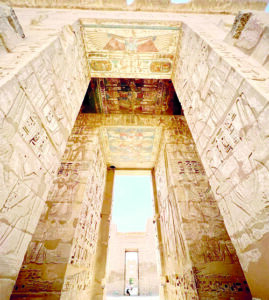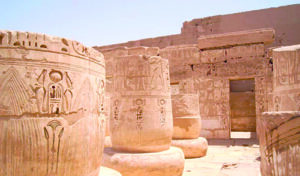Medinet Habu is the second largest ancient temple ever discovered in Egypt.
It covers an area of 66,000 square metres. The temple, a top Luxor tourist attraction, was built specifically as a mortuary temple by Ramesses III, the second pharaoh of the 20th dynasty, and also the last great pharaoh of the New Kingdom.
While the temple was built for Ramesses III to practice mortuary rituals, it was also used as a place for worshiping the god Amun.

Given its vast size and grandeur, some historians and experts speculated that Ramesses III had actually attempted to rival the temple built by the great Ramesses II which coincidentally is also located nearby on the West Bank of the Nile River in Luxor.
Visitors of Medinet Habu enjoy Nile River cruises, although the site is also featured in some other tour packages as well.
Those who visit typically enter the site via a giant gateway that has two huge columns on either side.
After passing through the gateway, one can see the ruins of Ramesses III royal palace. One needs to spend some time taking in the sight of these ruins to fully appreciate the wealth of royalty during the New Kingdom era.
The 210 by 300 metre temple precinct is home to roughly 7,000 square metres of well-preserved reliefs.
Many of these show depictions related the defeat of the Sea Peoples during the reign of Ramesses III.

Others depict scenes of various religious rituals and ceremonies, all of which are among the best preserved reliefs ever found.
After passing through the first pylon, visitors find themselves in a huge courtyard that is lined with massive statues of Ramesses III on one side and plain columns on the other.
Visitors then proceed through the second and third pylons which lead to the old hypostyle hall.
The hall would have at one time had a roof, but it is no longer there today.
The hypostyle hall is once again home to many well-preserved reliefs, but one of the most interesting things about the hall is the fact that archeologists discovered a large number of human heads on display.
It is believed that they once belonged to captives and were put on display as a symbol of Ramesses III control of Nubia and Syria.
Visitors today, however, will not see any heads since they were all removed from the site.
Beside the Mortuary Temple of Ramesses III at Medinet Habu, there is also a small temple dedicated to the god Amun. This temple was originally built by Queen Hatshepsut and then later altered by King Tuthmosis III, before being modified once again during the Roman period.
Most Nile cruises from Luxor to Aswan include a visit to this site, even as the site is not featured in all cruise packages.







Discussion about this post